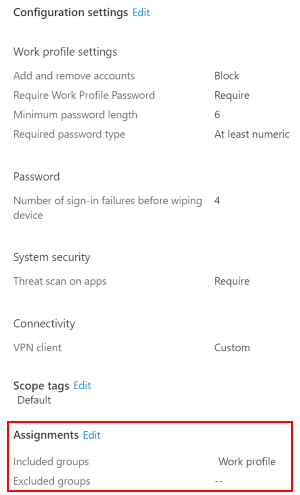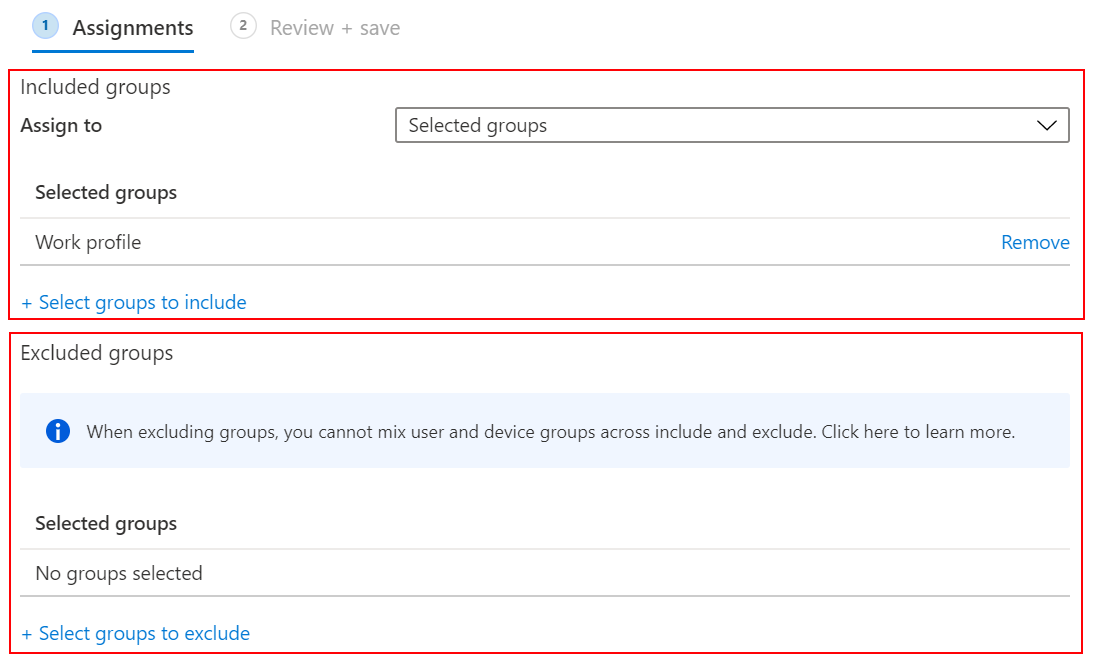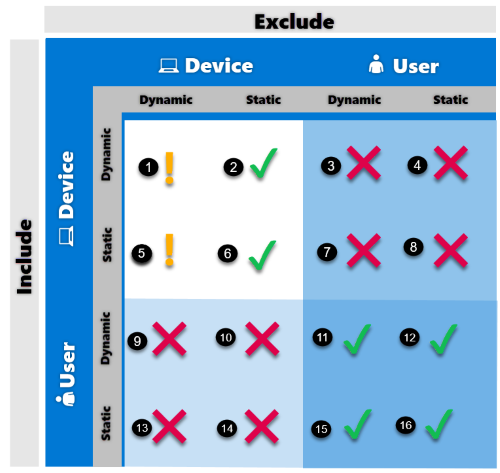You create a device configuration profile, and it includes all the settings you entered. The next step is to deploy or “assign” the profile to your user or device groups. When it’s assigned, the users and devices receive your profile, and the settings you entered are applied.
This article shows you how to assign a profile, and includes some information on using scope tags on your device configuration profiles.
For information on device configuration profiles, and what you can configure, go to Apply features and settings on your devices using device profiles in Microsoft Intune.
Note
When a profile is removed or no longer assigned to a device, different things can happen, depending on the settings in the profile. The settings are based on CSPs, and each CSP can handle the profile removal differently. For example, a setting might keep the existing value, and not revert back to a default value. The behavior is controlled by each CSP in the operating system. For a list of Windows CSPs, see configuration service provider (CSP) reference.
To change a setting to a different value, create a new profile, configure the setting to Not configured, and assign the profile. Once applied to the device, users should have control to change the setting to their preferred value.
When configuring these settings, we suggest deploying to a pilot group. For more Intune rollout advice, see create a rollout plan.
Before you begin
Be sure you have the correct role to assign profiles. For more information, see Role-based access control (RBAC) with Microsoft Intune.
Assign a device profile
- Sign in to the Microsoft Endpoint Manager admin center.
- Select Devices > Configuration profiles. All the profiles are listed.
- Select the profile you want to assign > Properties > Assignments > Edit:

- Select Included groups or Excluded groups, and then choose Select groups to include. When you select your groups, you’re choosing an Azure AD group. To select multiple groups, hold down the Ctrl key, and select your groups.

- Select Review + Save. This step doesn’t assign your profile.
- Select Save. When you save, your profile is assigned. Your groups will receive your profile settings when the devices check in with the Intune service.
Use scope tags or applicability rules
When you create or update a profile, you can also add scope tags and applicability rules to the profile.
Scope tags are a great way to filter profiles to specific groups, such as US-NC IT Team or JohnGlenn_ITDepartment. Use RBAC and scope tags for distributed IT has more information.
On Windows 10/11 devices, you can add applicability rules so the profile only applies to a specific OS version or a specific Windows edition. Applicability rules has more information.
User groups vs. device groups
Many users ask when to use user groups and when to use device groups. The answer depends on your goal. Here’s some guidance to get you started.
Device groups
If you want to apply settings on a device, regardless of who’s signed in, then assign your profiles to a devices group. Settings applied to device groups always go with the device, not the user.
For example:
- Device groups are useful for managing devices that don’t have a dedicated user. For example, you have devices that print tickets, scan inventory, are shared by shift workers, are assigned to a specific warehouse, and so on. Put these devices in a devices group, and assign your profiles to this devices group.
- You create a Device Firmware Configuration Interface (DFCI) Intune profile that updates settings in the BIOS. For example, you configure this profile to disable the device camera, or lock down the boot options to prevent users from booting up another OS. This profile is a good scenario to assign to a devices group.
- On some specific Windows devices, you always want to control some Microsoft Edge settings, regardless of who’s using the device. For example, you want to block all downloads, limit all cookies to the current browsing session, and delete the browsing history. For this scenario, put these specific Windows devices in a devices group. Then, create an Administrative Template in Intune, add these device settings, and then assign this profile to the devices group.
To summarize, use device groups when you don’t care who’s signed in on the device, or if anyone signs in. You want your settings to always be on the device.
User groups
Profile settings applied to user groups always go with the user, and go with the user when signed in to their many devices. It’s normal for users to have many devices, such as a Surface Pro for work, and a personal iOS/iPadOS device. And, it’s normal for a person to access email and other organization resources from these devices.
If a user has multiple devices on the same platform, then you can use filters on the group assignment. For example, a user has a personal iOS/iPadOS device, and an organization-owned iOS/iPadOS. When you assign a policy for that user, you can use filters to target only the organization-owned device.
Follow this general rule: If a feature belongs to a user, such as email or user certificates, then assign to user groups.
For example:
- You want to put a Help Desk icon for all users on all their devices. In this scenario, put these users in a users group, and assign your Help Desk icon profile to this users group.
- A user receives a new organization-owned device. The user signs in to the device with their domain account. The device is automatically registered in Azure AD, and automatically managed by Intune. This profile is a good scenario to assign to a users group.
- Whenever a user signs in to a device, you want to control features in apps, such as OneDrive or Office. In this scenario, assign your OneDrive or Office profile settings to a users group.For example, you want to block untrusted ActiveX controls in your Office apps. You can create an Administrative Template in Intune, configure this setting, and then assign this profile to a users group.
To summarize, use user groups when you want your settings and rules to always go with the user, whatever device they use.
Windows CSPs
The policy settings for Windows devices are based on the configuration service providers (CSPs). These settings map to registry keys or files on the devices.
Endpoint Manager exposes these CSPs so you can configure these settings and assign them to your Windows devices. These settings are configurable using the built-in templates and using the settings catalog. In the settings catalog, you’ll see that some settings apply to the user scope and some settings apply to the device scope.
For information on how user scoped and device scoped settings are applied to Windows devices, go to Settings catalog: Device scope vs. user scope settings.
Exclude groups from a profile assignment
Intune device configuration profiles let you include and exclude groups from profile assignment.
As a best practice:
- Create and assign profiles specifically for your user groups. Use filters to include or exclude devices of those users.
- Create and assign different profiles specifically for your device groups.
For more information on groups, see Add groups to organize users and devices.
Fundamentals
When you assign your policies and profiles, apply the following general principles:
- Think of Included groups or Excluded groups as a starting point for the users and devices that will receive your policies. The Azure AD group is the limiting group, so use the smallest group scope possible. Use filters to limit or refine your policy assignment.
- Assigned Azure AD groups, also known as static groups, can be added to Included groups or Excluded groups.Typically, you statically assign devices into an Azure AD group if they’re pre-registered in Azure AD, like with Windows Autopilot. Or, if you want to combine devices for a one-off, ad-hoc deployment. Otherwise, it might not be practical to statically assign devices into an Azure AD group.
- Dynamic Azure AD user groups can be added to Included groups or Excluded groups.
- Dynamic Azure AD device groups can be added to Included groups. But, there can be latency when populating the dynamic group membership. In latency-sensitive scenarios, use filters to target specific devices, and assign your policies to user groups.For example, you want policies assigned to devices as soon as they enroll. In this latency-sensitive situation, create a filter to target the devices you want, and assign the policy with this filter to user groups. Don’t assign to device groups.In a userless scenario, create a filter to target the devices you want, and assign the policy with the filter to the “All devices” group.
- Avoid adding dynamic Azure AD device groups to Excluded groups. Latency in dynamic device group calculation at enrollment can cause undesirable results. For example, unwanted apps and policies might be deployed before the excluded group membership is populated.
Support matrix
Use the following matrix to understand support for excluding groups:
- ✔️: Supported
- ❌: Not supported
- ❕ : Partially supported

| Scenario | Support |
|---|---|
| 1 | ❕ Partially supported Assigning policies to a dynamic device group while excluding another dynamic device group is supported. But, it’s not recommended in scenarios that are sensitive to latency. Any delay in exclude group membership calculation can cause policies to be offered to devices. In this scenario, we recommend using filters instead of dynamic device groups for excluding devices. For example, you have a device policy that’s assigned to All devices. Later, you have a requirement that new marketing devices don’t receive this policy. So, you create a dynamic device group called Marketing devices based on the enrollmentProfilename property (device.enrollmentProfileName -eq "Marketing_devices"). In the policy, you add the Marketing devices dynamic group as an excluded group.A new marketing device enrolls in Intune for the first time, and a new Azure AD device object is created. The dynamic grouping process puts the device into the Marketing devices group with a possible delayed calculation. At the same time, the device enrolls into Intune, and starts receiving all applicable policies. The Intune policy may be deployed before the device is put in the exclusion group. This behavior results in an unwanted policy (or app) being deployed to the Marketing devices group. As a result, it’s not recommended to use dynamic device groups for exclusions in latency sensitive scenarios. Instead, use filters. |
| 2 | ✔️ Supported Assigning a policy to a dynamic device group while excluding a static device group is supported. |
| 3 | ❌ Not supported Assigning a policy to a dynamic device group while excluding user groups (both dynamic and static) isn’t supported. Intune doesn’t evaluate user-to-device group relationships, and devices of the included users won’t be excluded. |
| 4 | ❌ Not supported Assigning a policy to a dynamic device group and excluding user groups (both dynamic and static) isn’t supported. Intune doesn’t evaluate user-to-device group relationships, and devices of the included users won’t be excluded. |
| 5 | ❕ Partially supported Assigning a policy to a static device group while excluding a dynamic device group is supported. But, it’s not recommended in scenarios that are sensitive to latency. Any delay in exclude group membership calculation can cause policies to be offered to devices. In this scenario, we recommend using filters instead of dynamic device groups for excluding devices. |
| 6 | ✔️ Supported Assigning a policy to a static device group and excluding a different static device group is supported. |
| 7 | ❌ Not supported Assigning a policy to a static device group and excluding user groups (both dynamic and static) isn’t supported. Intune doesn’t evaluate user-to-device group relationships, and devices of the included users won’t be excluded. |
| 8 | ❌ Not supported Assigning a policy to a static device group and excluding user groups (both dynamic and static) isn’t supported. Intune doesn’t evaluate user-to-device group relationships, and devices of the included users won’t be excluded. |
| 9 | ❌ Not supported Assigning a policy to a dynamic user group and excluding device groups (both dynamic and static) isn’t supported. |
| 10 | ❌ Not supported Assigning a policy to a dynamic user group and excluding device groups (both dynamic and static) isn’t supported. |
| 11 | ✔️ Supported Assigning a policy to a dynamic user group while excluding other user groups (both dynamic and static) is supported. |
| 12 | ✔️ Supported Assigning a policy to a dynamic user group while excluding other user groups (both dynamic and static) is supported. |
| 13 | ❌ Not supported Assigning a policy to a static user group while excluding device groups (both dynamic and static) isn’t supported. |
| 14 | ❌ Not supported Assigning a policy to a static user group while excluding device groups (both dynamic and static) isn’t supported. |
| 15 | ✔️ Supported Assigning a policy to a static user group while excluding other user groups (both dynamic and static) is supported. |
| 16 | ✔️ Supported Assigning a policy to a static user group while excluding other user groups (both dynamic and static) is supported. |
Next steps
See monitor device profiles for guidance on monitoring your profiles, and the devices running your profiles.
Ref: Assign device profiles in Microsoft Intune | Microsoft Learn